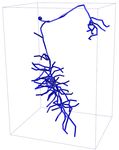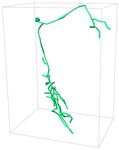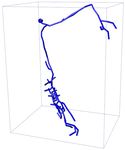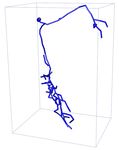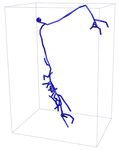Voxel-wise Cross-Volume Representation Learning for 3D Neuron Reconstruction
←
→
Page content transcription
If your browser does not render page correctly, please read the page content below
Voxel-wise Cross-Volume Representation
Learning for 3D Neuron Reconstruction
Heng Wang1 , Chaoyi Zhang1 , Jianhui Yu1 , Yang Song2 , Siqi Liu3 , Wojciech
Chrzanowski4,5 , Weidong Cai1( )
1
School of Computer Science, University of Sydney, Sydney, Australia
arXiv:2108.06522v2 [eess.IV] 16 Sep 2021
tom.cai@sydney.edu.au
2
School of Computer Science and Engineering, University of New South Wales,
Sydney, Australia
3
Paige AI, New York, NY, USA
4
Sydney Pharmacy School, University of Sydney, Sydney, Australia
5
Sydney Nano Institute, University of Sydney, Sydney, Australia
Abstract. Automatic 3D neuron reconstruction is critical for analysing
the morphology and functionality of neurons in brain circuit activities.
However, the performance of existing tracing algorithms is hinged by the
low image quality. Recently, a series of deep learning based segmentation
methods have been proposed to improve the quality of raw 3D optical
image stacks by removing noises and restoring neuronal structures from
low-contrast background. Due to the variety of neuron morphology and
the lack of large neuron datasets, most of current neuron segmentation
models rely on introducing complex and specially-designed submodules
to a base architecture with the aim of encoding better feature represen-
tations. Though successful, extra burden would be put on computation
during inference. Therefore, rather than modifying the base network, we
shift our focus to the dataset itself. The encoder-decoder backbone used
in most neuron segmentation models attends only intra-volume voxel
points to learn structural features of neurons but neglect the shared in-
trinsic semantic features of voxels belonging to the same category among
different volumes, which is also important for expressive representation
learning. Hence, to better utilise the scarce dataset, we propose to ex-
plicitly exploit such intrinsic features of voxels through a novel voxel-
level cross-volume representation learning paradigm on the basis of an
encoder-decoder segmentation model. Our method introduces no extra
cost during inference. Evaluated on 42 3D neuron images from BigNeuron
project, our proposed method is demonstrated to improve the learning
ability of the original segmentation model and further enhancing the
reconstruction performance.
Keywords: Deep learning · Neuron reconstruction· 3D image segmen-
tation· 3D optical microscopy
1 Introduction
3D neuron reconstruction is essential for analysis of brain circuit activities to
understand how human brain works [25,12,13,21]. It traces neurons and recon-2 H. Wang et al.
structs their morphology from 3D light microscopy image stacks for neuroscien-
tists to investigate the identity and functionality of neurons. Traditional trac-
ing algorithms rely on hand-crafted features to capture neuronal structures but
they are sensitive to the image quality. However, due to various imaging condi-
tions, obtained neuron images suffer from different extent of noises and uneven
labelling distribution. To attain better tracing performance for 3D neuron recon-
struction, an accurate segmentation method to distinguish a neuron voxel from
its surrounding low-contrast background is in high demand and necessary. How-
ever, due to the complexity of neuronal structures and various imaging artefacts,
the precise restoration of neuronal voxels remains a challenging task.
A line of deep learning based segmentation models [10,26,19,20,9,22,17] has
recently been proposed to demonstrate their advances in neuron segmentation
studies. Since the neuronal structures range from long tree-like branches to blob-
shape somas, [10] adopted inception networks [16] with various kernel sizes to
better learn neuron representations from an enlarged receptive field. The in-
vention of U-Net [15] gave rise to a line of encoder-decoder architectures and
popularised them to be one of the de-facto structures in medical image segmen-
tation tasks. Under the unsupervised setting, traditional tracing algorithm is
combined with 3D U-Net [6] to progressively learn representative feature and
the learned network, in turn, helps improve the tracing performance [26]. In the
fully-supervised manner, modifications have been made based on 3D U-Net to
extend the receptive field of kernels. In MKF-Net [19], a multi-scale spatial fusion
convolutional block, where kernels with different size are processed in parallel
and fused together, was proposed to replace some of the encoder blocks of 3D
U-Net and achieved better segmentation results. Further, [20] introduces graph-
based reasoning to learn longer-range connection for more complete features.
The bottom layer of 3D U-Net encodes the richest semantic information but
loses the spatial information. To alleviate the loss of spatial cues, [9] proposed
to replace the bottom layer with a combination of dilated convolutions [3] and
spatial pyramid pooling operations [8]. Although larger local regions have been
aggregated after introducing these modifications and better segmentation results
have been gained, additional overhead for the inference has also been introduced
when using these proposed models. To avoid such overhead, [22] and [17] use ad-
ditional teacher-student model and GAN-based data augmentation techniques,
respectively. However, the focus of these segmentation models resides in the
learning of local structural information of neurons within a single volume while
the intrinsic semantic information of voxels among different volumes has been
rarely touched.
As the semantic label is able to help obtain a better representation for im-
age pattern recognition [24,23], such intrinsic features are beneficial to visual
analysis. Siamese networks [1] based unsupervised representation learning meth-
ods [4,7,5] have recently gained impressive performance over image-level classi-
fication task by generating better latent representations through the compari-
son between two augmented views of the same image. Inspired by these work,
we propose to encode the intrinsic semantic features into the representation ofVCV-RL for 3D Neuron Reconstruction 3
each voxel by maximising the similarity between two voxels belonging to the
same class in a high-dimensional latent space. In our work, we follow the preva-
lent encoder-decoder architecture as the base segmentation model. Without the
need of negative pairs [4] and momentum encoder [7], we design a class-aware
voxel-wise Simple Siamese (SimSiam) [5] learning paradigm in a fully-supervised
manner to maximise the similarity between two voxels with the same semantic
meaning and encourage the base encoder to learn a better latent space for voxels
of neuron images. Rather than being restricted within the same volume, to fully
utilise the dataset, the voxel pairs can be sampled among different volumes. Af-
ter training, only the original segmentation base model will be kept. Therefore,
no extra cost is required to perform inference. Experimental results on 42 3D
optical microscopy neuron images from the BigNeuron project [14] show that our
proposed framework is able to achieve better segmentation results and further
increase the accuracy of the tracing results.
Fig. 1: Our proposed training paradigm.
2 Method
2.1 Supervised Encoder-Decoder Neuron Segmentation
We apply a 3D encoder-decoder architecture as the base model to perform neuron
segmentation. As shown in Fig. 1, it consists of an encoder path, a decoder path,
and skip connections linking in between, whoseh training progress is supervised
i via
CE
a binary cross-entropy loss that L = −log Y log(Y ) + (1 − Y )log(Y ) , where
e e
Y and Ye represent the ground truth and the predictions of neuron segmentation
masks, respectively.4 H. Wang et al.
LCE provides semantic cues for each individual voxel but the relation learnt
through the encoder is only within a local neighbourhood of each voxel, which
ignores the correlation among voxels belonging to the same semantic class in a
long distance, i.e., cross-volume. To decrease the distance of voxels with same
category in the latent space, we introduce our proposed voxel-wise cross-volume
SimSiam representation learning in next section.
2.2 VCV-RL: Voxel-wise Cross-Volume SimSiam Representation
Learning
As demonstrated in Fig. 1, for each volume Vi ∈ RD×H×W where D, H, and W
denote the depth, height, and width, respectively, we first obtain its correspond-
ing downsized d-dimensional latent code through encoders, and then interpolate
it back to same size as Vi to reach a voxel-wise embedding Ci . Then, these M
volumes of latent codes C ∈ RM ×D×H×W ×d are divided according to the ground
truth labels Yi , for the construction of two cross-volume point pools, one for the
neurons voxels PN and one for the background voxels PB . In other words, each
pool contains the latent codes of voxels belonging to the same class from all the
volumes within a training batch.
To enforce the voxel embeddings within the same class-aware pool to be closer
in their latent space, we adopt Siamese networks [1] to perform the similarity
comparison for each input voxel pair, and we denote the voxel to compare as
the anchor-voxel and the voxel being compared as the pair-voxel. Following [5],
we use a 3-layer MLP projector f as the channel mapping function to raise the
latent code dimension from d to dp , for both types of voxels. Another 2-layer
MLP predictor h is employed to match the output of anchor-voxel to that of the
pair-voxel. To prevent the Siamese networks from collapsing to constant solution,
a stop-gradient operation [5] is also adopted as shown in Fig. 1.
Voxel Similarity. Following SimSiam [5], the symmetrised similarity loss be-
tween an anchor-voxel j and a pair-voxel k is defined with cos operator as:
1
Lcos
j,k = (1 − cos[h(f (j)), f (k)]), (1)
2
u v
where cos[u, v] = kuk 2
· kvk2
denotes the cosine similarity between two embed-
dings. The total similarity loss comparing N voxel pairs is formulated as:
N
X 1 X 1 1 cos
LSIM = ( Lcos
j,k + Lk,j ) (2)
N 2 2
∗∈[N ,B] j∈P∗ ,k∈P∗
Together with loss LCE , the encoded feature embedding for each voxel is
expected to contain the intrinsic semantic cues shared among voxels of the same
category. As the point-wise cross-entropy loss is complimentary to the represen-
tation learning loss [23], we keep the weight of these two losses the same. The
segmentation loss is then formulated as Lseg = LCE + LSIM .VCV-RL for 3D Neuron Reconstruction 5
Anchor-Voxel Sampling Strategy. Given that latent codes of voxels be-
ing misclassified by the base segmentation model are more important for the
representation learning [23], we design three different strategies to sample N
anchor-voxels from each point pool P∗ :
– Random sampling (AS random ): Randomly sample N anchor-voxels from the
whole point pool P∗ ;
– Purely hard sampling (AS PH ): Randomly sample N anchor-voxels from a
subset of point pool P∗ . The subset is the collection of voxels whose predic-
tion is wrong;
– Hybrid combination sampling (AS hybrid ): N2 anchor-voxels are randomly
sampled from the whole point pool P∗ while the rest N2 anchor-voxels are
randomly sampled from the subset stated in AS PH .
Pair-Voxel Sampling Strategy. For each selected anchor-voxel, a pair-voxel
is sampled from the same point pool to feed together into the Siamese networks.
Apart from the candidate points in point pool P∗ , we propose a virtual point
dscPN and dscPB as point descriptor for point pool PN and PB , respectively to
represent an aggregation of semantic feature for each class. We design two ways
of computing such a virtual point:
– Relaxed: Average pooling of the entire point pool;
– Strict: Average pooling of the subset of correctly classified points from the
entire point pool.
To avoid outliers and stabilise the learning, inspired by Momentum2 Teacher [11],
we propose to use a momentum update mechanism to keep the semantic infor-
mation of past pool descriptors. Formally, the pool descriptor for each pool is
defined as:
dsckP∗ = (1 − α)dsckP∗ + αdsck−1 P∗ , (3)
where k is the current iteration. α is the momentum coefficient and decreases
from αbase = 1 to 0 with cosine scheduling policy [11] defined as α = αbase (cos( πk
K )+
1)/2, where K is the total number of iterations.
3 Experiments and Results
3.1 Dataset and Implementation Details
Dataset. Our studies on 3D neuron reconstruction were conducted on the pub-
licly available 42-volume Janelia dataset developed for the BigNeuron project [14],
which was further divided into 35, 3, and 4 samples as training, validation, and
testing set, respectively. We applied random horizontal and vertical flipping, ro-
tation, and cropping, as data augmentation techniques, to amplify our training
set with 3D patches of size 128×128×64. Given that the number of neuron voxels
is dramatically smaller than that of the background voxels, to ensure the exis-
tence of foreground neuron voxels, we re-choose the patch until the foreground
voxels make up over 0.1% of the whole patch.6 H. Wang et al.
Network Setting and Implementation. All the models involved in the ex-
periments were implemented in PyTorch 1.5 and trained from scratch for 222
epochs. A model was saved when it reached a better F1-score on the validation
set. We use Adam as the optimizer with the learning rate of 1 × 10−3 and the
weight decay of 1 × 10−4 . The batch size M is set as 4. We choose AS hybrid with
the number of anchor-voxels N as 512 and strict pool descriptor with MoUp-
date mechanism. The hidden layer dimension is 512 and 128 for the projector
and predictor, respectively. d and dp are set as 128 and 512, respectively. To
make fair comparison, all the 3D U-Net based segmentation models including
Li2019 [9] and MKF-Net [19] were implemented with feature dimensions of 16,
32, 64, and 128 for respective layer from top to bottom. As for 3D LinkNet [2], in
addition, we replaced the head and final blocks with convolutional layer without
spatial changes to keep the same 3 times downsampling of feature maps.
3.2 Results and Analysis
To quantitatively compare among different methods for 3D neuron segmentation,
we reported F1, Precision, and Recall as the evaluation metrics. They measure
the similarity between the prediction and the ground truth segmentation. Fol-
lowing [9], we employed three extra metrics for the reconstruction results: entire
structure average (ESA), different structure average (DSA), and percentage of
different structures (PDS) for the measurement between the traced neuron and
the manually annotated neurons.
Segmentation Results. The quantitative segmentation result is presented in
Table 1. Our proposed method achieves the best F1 score among all the other
state-of-the-art segmentation methods and improves the performance of the base
U-Net by 2.32%. It is also noticeable that our model includes no additional cost
during inference. Our proposed VCV-RL module can be applied on the encoder
output of encoder-decoder architecture easily. When applied on the 3D LinkNet,
VCV-RL can enhance the segmentation performance by almost 2%.
Method F1 (%) Precision (%) Recall (%) #Params
Li2019 [9] 52.69±12.49 46.50±12.70 61.06±11.50 2.3M
3DMKF-Net [19] 52.31±12.14 46.51±11.82 59.88±12.32 1.5M
3D U-Net [6] 51.26±12.16 45.26±11.98 59.35±12.28 1.4M
+ VCV-RL (proposed) 53.54±11.39 46.68±11.58 63.02±10.38 1.4M
3D LinkNet [2] 50.74±12.67 42.93±11.41 62.22±14.50 2.1M
+ VCV-RL 52.66±12.14 46.10±11.92 61.55±11.87 2.1M
Table 1: Segmentation performance on 3D neuron reconstruction.VCV-RL for 3D Neuron Reconstruction 7
Method ESA ↓ DSA ↓ PDS ↓ F1 (%)↑ Prec. (%)↑ Recall (%)↑
APP2 [25] 3.62±0.76 6.80±1.24 0.34±0.03 55.84±12.96 57.48±13.77 64.94±23.10
+ U-Net [6] 1.59±0.19 3.66±0.81 0.22±0.02 64.92±15.33 86.23±7.76 56.30±19.39
+ MKF-Net [19] 1.62±0.21 3.85±0.76 0.22±0.03 65.15±14.93 89.03±8.74 55.07±18.13
+ Proposed 1.52±0.21 3.48±0.29 0.21±0.02 66.17±14.39 87.25±7.41 56.87±17.92
Table 2: Tracing performance on 3D neuron reconstruction.
Input 3D U-Net 3D MKF-Net Proposed GT
APP2 +3D U-Net +3D MKF-Net +Proposed Manual
Fig. 2: Visualization of segmentation (above) and reconstruction (bottom) results
for an example 3D neuron image. + refers performing APP2 on the segmented
results from the segmentation model.
Neuron Reconstruction Results. To validate whether the proposed segmen-
tation method can facilitate the tracing algorithm, we choose the state-of-the-art
tracing algorithm APP2 [25] as the main tracer. As in [10], we perform the trac-
ing algorithm on adjusted input volume using the probability map predicted from
each segmentation model. As presented in Table 2, without extra overhead dur-
ing inference, our proposed method combined with the tracer achieves the best
quantitative tracing results on all the metrics among all the other deep learning
based reconstruction methods except for the precision. The reason why plain
APP2 reaches such high recall is that it overtraces the neuron structures, which
is likely to include more real neuron points. Fig. 2 displays the enhanced segmen-
tation results after the image adjustment operation proposed in [10] in the first
row. The second row presents the tracing results after applying APP2 [25] on the
segmented images produced by different segmentation methods. Our proposed
method combined with APP2 achieves competitive tracing result. We note that
joint training of segmentation and tracing may further improve the 3D neuron
reconstruction performance [18].8 H. Wang et al.
Ablation Study. As presented in Table 3, model B, C, and D.1 reach better F1
score than Model A, which demonstrates the effect of representation learning in
improving learning ability of the base U-Net model and the superiority of hybrid
anchor sampling strategy. The reason why model D.2 and D.3 outperform D.1
is because the existence of the proposed pool descriptor dscP can help improve
the generality of the latent space. The strict way of computing dscP can further
enhance the segmentation performance. We also try to remove the momentum
update mechanism of dscP and the experiment result of model E demonstrates
the importance of past information storage. In addition, we conducted experi-
ments on the proposed method with different number of anchor-voxels N . The
result is presented in Fig. 3. When N is 512, the F1-score is largest.
ID Method F1 (%)
A U-Net 51.26
B +AS random 53.19
C +AS PH 52.69
D +AS hybrid
D.1 w/o dscP 53.20
D.2 w/ dscP (relaxed) 53.34
D.3 w/ dscP (strict) 53.54
E D.3 w/o MoUpdate 53.09
σ
Table 3: Results of ablation studies. Fig. 3: µ ± 3 curves against log N .
4 Conclusions
In this paper, we propose a novel voxel-wise cross-volume representation learning
with the aim of facilitating the challenging 3D neuron reconstruction task. The
segmentation of 3D neuron image is beneficial to improve the performance of
tracing algorithms but is challenging due to various imaging artefacts and com-
plex neuron morphology. Recent deep learning based methods rely on specially-
designed structures in order to fully utilise the scarce 3D dataset. Though ef-
fective, extra computational costs have also been introduced. To make better
use of the small dataset without sacrificing the efficiency during inference, we
propose a novel training paradigm which consists of a SimSiam representation
learning module to explicitly encode the semantic cues into the latent code of
each voxel by comparing two voxels belonging to the same semantic category
among different volumes. Compared to other methods, our proposed method
learns a better latent space for the base model without modifying any part of it.
And our proposed method shows superior performance in both the segmentation
and reconstruction tasks.VCV-RL for 3D Neuron Reconstruction 9
References
1. Bromley, J., Guyon, I., LeCun, Y., Säckinger, E., Shah, R.: Signature verification
using a ”siamese” time delay neural network. Advances in Neural Information
Processing Systems (NeurIPS) pp. 737–737 (1994)
2. Chaurasia, A., Culurciello, E.: Linknet: Exploiting encoder representations for ef-
ficient semantic segmentation. In: 2017 IEEE Visual Communications and Image
Processing (VCIP). pp. 1–4. IEEE (2017)
3. Chen, L.C., Zhu, Y., Papandreou, G., Schroff, F., Adam, H.: Encoder-decoder with
atrous separable convolution for semantic image segmentation. In: Proceedings of
the European Conference on Computer Vision (ECCV). pp. 801–818 (2018)
4. Chen, T., Kornblith, S., Norouzi, M., Hinton, G.: A simple framework for con-
trastive learning of visual representations. In: International Conference on Machine
Learning (ICML). pp. 1597–1607. PMLR (2020)
5. Chen, X., He, K.: Exploring simple siamese representation learning. arXiv preprint
arXiv:2011.10566 (2020)
6. Çiçek, Ö., Abdulkadir, A., Lienkamp, S.S., Brox, T., Ronneberger, O.: 3D U-Net:
learning dense volumetric segmentation from sparse annotation. In: International
Conference on Medical Image Computing and Computer-Assisted Intervention
(MICCAI). pp. 424–432. Springer (2016)
7. Grill, J.B., Strub, F., Altché, F., Tallec, C., Richemond, P.H., Buchatskaya, E.,
Doersch, C., Pires, B.A., Guo, Z.D., Azar, M.G., et al.: Bootstrap your own latent:
A new approach to self-supervised learning. arXiv preprint arXiv:2006.07733 (2020)
8. He, K., Zhang, X., Ren, S., Sun, J.: Spatial pyramid pooling in deep convolu-
tional networks for visual recognition. IEEE Transactions on Pattern Analysis and
Machine Intelligence (TPAMI) 37(9), 1904–1916 (2015)
9. Li, Q., Shen, L.: 3D neuron reconstruction in tangled neuronal image with deep
networks. IEEE Transactions on Medical Imaging (TMI) 39(2), 425–435 (2019)
10. Li, R., Zeng, T., Peng, H., Ji, S.: Deep learning segmentation of optical microscopy
images improves 3-D neuron reconstruction. IEEE Transactions on Medical Imag-
ing (TMI) 36(7), 1533–1541 (2017)
11. Li, Z., Liu, S., Sun, J.: Momentum2 teacher: Momentum teacher with momentum
statistics for self-supervised learning. arXiv preprint arXiv:2101.07525 (2021)
12. Liu, S., Zhang, D., Liu, S., Feng, D., Peng, H., Cai, W.: Rivulet: 3D neuron
morphology tracing with iterative back-tracking. Neuroinformatics 14(4), 387–401
(2016)
13. Liu, S., Zhang, D., Song, Y., Peng, H., Cai, W.: Automated 3-D neuron tracing with
precise branch erasing and confidence controlled back tracking. IEEE Transactions
on Medical Imaging (TMI) 37(11), 2441–2452 (2018)
14. Peng, H., Hawrylycz, M., Roskams, J., Hill, S., Spruston, N., Meijering, E., Ascoli,
G.A.: BigNeuron: large-scale 3D neuron reconstruction from optical microscopy
images. Neuron 87(2), 252–256 (2015)
15. Ronneberger, O., Fischer, P., Brox, T.: U-Net: Convolutional networks for biomedi-
cal image segmentation. In: International Conference on Medical Image Computing
and Computer-Assisted Intervention (MICCAI). pp. 234–241. Springer (2015)
16. Szegedy, C., Liu, W., Jia, Y., Sermanet, P., Reed, S., Anguelov, D., Erhan, D.,
Vanhoucke, V., Rabinovich, A.: Going deeper with convolutions. In: Proceedings
of the IEEE conference on Computer Vision and Pattern Recognition (CVPR).
pp. 1–9 (2015)10 H. Wang et al.
17. Tang, Z., Zhang, D., Song, Y., Wang, H., Liu, D., Zhang, C., Liu, S., Peng, H., Cai,
W.: 3D conditional adversarial learning for synthesizing microscopic neuron image
using skeleton-to-neuron translation. In: 2020 IEEE 17th International Symposium
on Biomedical Imaging (ISBI). pp. 1775–1779. IEEE (2020)
18. Tregidgo, H.F., Casamitjana, A., Latimer, C.S., Kilgore, M.D., Robinson, E.,
Blackburn, E., Van Leemput, K., Fischl, B., Dalca, A.V., Mac Donald, C.L.,
et al.: 3D reconstruction and segmentation of dissection photographs for MRI-
free neuropathology. In: International Conference on Medical Image Computing
and Computer-Assisted Intervention (MICCAI). pp. 204–214. Springer (2020)
19. Wang, H., Zhang, D., Song, Y., Liu, S., Huang, H., Chen, M., Peng, H., Cai, W.:
Multiscale kernels for enhanced U-shaped network to improve 3D neuron tracing.
In: Proceedings of the IEEE/CVF Conference on Computer Vision and Pattern
Recognition (CVPR) Workshops. pp. 1105–1113 (2019)
20. Wang, H., Song, Y., Zhang, C., Yu, J., Liu, S., Pengy, H., Cai, W.: Single neuron
segmentation using graph-based global reasoning with auxiliary skeleton loss from
3D optical microscope images. In: 2021 IEEE 18th International Symposium on
Biomedical Imaging (ISBI). pp. 934–938. IEEE (2021)
21. Wang, H., Zhang, D., Song, Y., Liu, S., Gao, R., Peng, H., Cai, W.: Memory and
time efficient 3D neuron morphology tracing in large-scale images. In: 2018 Digital
Image Computing: Techniques and Applications (DICTA). pp. 1–8. IEEE (2018)
22. Wang, H., Zhang, D., Song, Y., Liu, S., Wang, Y., Feng, D., Peng, H., Cai, W.:
Segmenting neuronal structure in 3D optical microscope images via knowledge
distillation with teacher-student network. In: 2019 IEEE 16th International Sym-
posium on Biomedical Imaging (ISBI). pp. 228–231. IEEE (2019)
23. Wang, W., Zhou, T., Yu, F., Dai, J., Konukoglu, E., Van Gool, L.: Exploring cross-
image pixel contrast for semantic segmentation. arXiv preprint arXiv:2101.11939
(2021)
24. Wei, L., Xie, L., He, J., Chang, J., Zhang, X., Zhou, W., Li, H., Tian, Q.: Can
semantic labels assist self-supervised visual representation learning? arXiv preprint
arXiv:2011.08621 (2020)
25. Xiao, H., Peng, H.: APP2: automatic tracing of 3D neuron morphology based on
hierarchical pruning of a gray-weighted image distance-tree. Bioinformatics 29(11),
1448–1454 (2013)
26. Zhao, J., Chen, X., Xiong, Z., Liu, D., Zeng, J., Zhang, Y., Zha, Z.J., Bi, G.,
Wu, F.: Progressive learning for neuronal population reconstruction from optical
microscopy images. In: International Conference on Medical Image Computing and
Computer-Assisted Intervention (MICCAI). pp. 750–759. Springer (2019)You can also read

